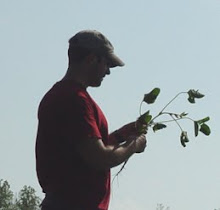
 There have been a few questions and concerns regarding the Blogbook assignment for this week. I've decided to post an example blog for today's activities, which was heavily focused on the sweep net samples from the alfalfa and soybean fields. Note, most of the items that should be addressed are located on the outline for the lab, which was handed out at the beginning of class. I will also post all handouts from today under the course content section of K-State Online. For this posting or any other posting for that matter, you're not restricted to the criteria that I give you. The idea here is to make these entries as "dynamic" as possible. Therefore, if you find supportive websites that help you understand key insect structures and/or function, then feel free to include it. Also remember to write most of your text in another word-editing program before pasting it into your blog posting. This will ensure that you don't lose your work as you compile your postings.
There have been a few questions and concerns regarding the Blogbook assignment for this week. I've decided to post an example blog for today's activities, which was heavily focused on the sweep net samples from the alfalfa and soybean fields. Note, most of the items that should be addressed are located on the outline for the lab, which was handed out at the beginning of class. I will also post all handouts from today under the course content section of K-State Online. For this posting or any other posting for that matter, you're not restricted to the criteria that I give you. The idea here is to make these entries as "dynamic" as possible. Therefore, if you find supportive websites that help you understand key insect structures and/or function, then feel free to include it. Also remember to write most of your text in another word-editing program before pasting it into your blog posting. This will ensure that you don't lose your work as you compile your postings.If you're not sure how to setup your blogbook, you can choose a more traditional route, which is to you have a brief introduction followed by materials and methods and a brief discussion (see below). This will be relevant or applicable for some lab exercises, but not all.
-----------------------EXAMPLE---------------------
Clever and/or identifiable title.
Results.
The number of feeding types found in each crop evaluated. The number of unique individuals or species found within each feeding group observed. Scanned image of insect selected for drawing (or turn it in if not comfortable with publishing your prized artwork!), images from your phone (assuming you took them), etc.
Insect from alfalfa field:
Discussion.
The purpose of the lab in your own words, your accomplishments, your experience with the exercise that you were given, challenges with the materials or concepts presented, etc.
What does this tell you about the type of damage you would expect to see in the fields sampled? Discuss the most challenging aspects of sorting specimens or this lab in general. Based on your experience, what are some potential limitations associated with sorting and identifying insects or other arthropods in the field? Other points you care to discuss.
Supplemental information.
Video or two of insect feeding, preferably of the ones you observed today. Diagrams or images of other insects with similar structures (mouth parts, antennae, legs, wings, etc.) that support your findings or observations from today. In short, use this posting as an opportunity to use the tools associated with your blogbook.
Filiform antennae examples that were similar to my drawings:


Images can be found at www.insectimages.org

Image can be found at www.insectimages.org
I found this great site that covers the topics and structure that we discussed in lab. It has some great antenna examples as well as mouth parts, both drawings and actual insect images. Here's the link.



No comments:
Post a Comment